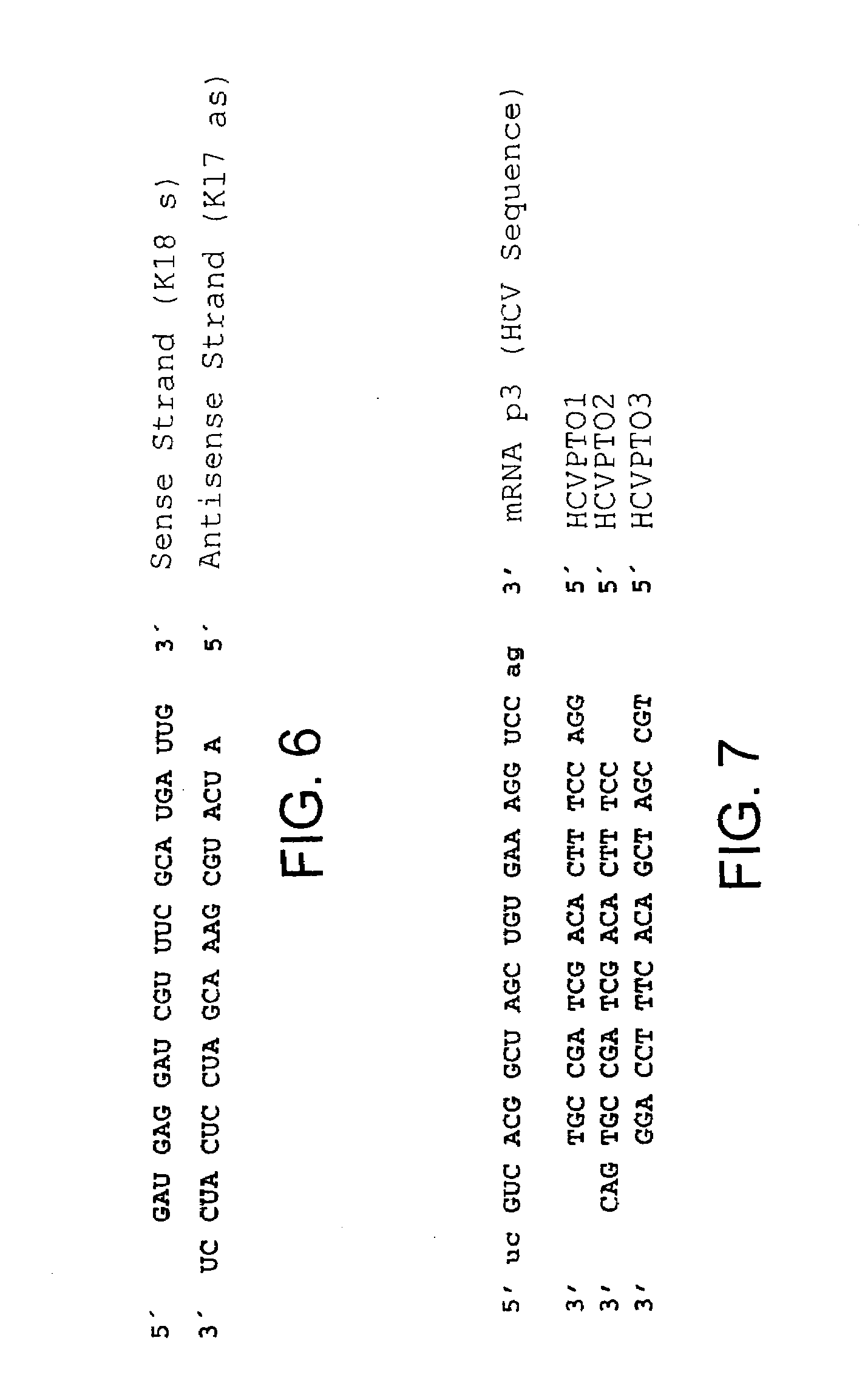Compositions and methods for inhibiting viral replication
a technology of double-stranded ribonucleic acid and dsrna, which is applied in the direction of biocide, drug composition, peptide/protein ingredients, etc., can solve the problems of hcv infection, complex treatment of hcv, and high mutation ra
- Summary
- Abstract
- Description
- Claims
- Application Information
AI Technical Summary
Benefits of technology
Problems solved by technology
Method used
Image
Examples
example 1
Inhibition of the 3′-UTR of HCV
[0063]To study RNA interference and the action of antisense oligonucleotides in a nonpathogenic assay, Sequence No. 1 in the sequence protocol was cloned in front of a gene that codes for E. coli β-galactosidase. Sequence No. 1 corresponds to a sequence from a highly conserved region of the 3′-UTR of the HCV genome that is 24 nucleotides in length. After transfection of the 3′-UTR plasmid in human HuH-7 liver cells, the sequence was transcribed as a part of an mRNA that codes for β-galactosidase. The mRNA sequence that corresponds to the 3′UTR is therefore identical to the HCV genome sequence and was subsequently used as the target sequence.
Generation of p2 and p3 Reporter Plasmids
[0064]The E. coli β-galactosidase (β-gal) gene was isolated from the commercially available expression vector pβ-Gal control (BD Biosciences Clontech, Tullastr. 4, 69126 Heidelberg, Germany, Gene Accession No. U13186, Nucleotide 280-3429).
[0065]The HCV sequence is part of a f...
example 2
Treatment of a HCV Infected Patient with dsRNA
[0093]In this Example, HCV specific double stranded dsRNAs are injected into HCV infected patients and shown to specifically inhibit HCV gene expression.
dsRNA Administration and Dosage
[0094]The present example provides for pharmaceutical compositions for the treatment of human HCV infected patients comprising a therapeutically effective amount of a HCV specific dsRNA as disclosed herein, in combination with a pharmaceutically acceptable carrier or excipient. DsRNAs useful according to the invention may be formulated for oral or parenteral administration. The pharmaceutical compositions may be administered in any effective, convenient manner including, for instance, administration by topical, oral, anal, vaginal, intravenous, intraperitoneal, intramuscular, subcutaneous, intranasal or intradermal routes, among others. One of skill in the art can readily prepare dsRNAs for injection using such carriers that include, but are not limited to,...
example 3
RNA Purification and Analysis
[0095]Efficacy of the dsRNA treatment is determined at defined intervals after the initiation of treatment using real time PCR on total RNA extracted from peripheral blood. Cytoplasmic RNA from whole blood, taken prior to and during treatment, is purified with the help of the RNeasy Kit (Qiagen, Hilden) and HCV mRNA levels are quantitated by real time RT-PCR.as described previously (Eder, M., et al., Leukemia(1999) 13:1383-1389; Scherr M et al., BioTechniques. (2001) 31:520-526).
PUM
| Property | Measurement | Unit |
|---|---|---|
| weight | aaaaa | aaaaa |
| weight | aaaaa | aaaaa |
| weight | aaaaa | aaaaa |
Abstract
Description
Claims
Application Information
 Login to View More
Login to View More - R&D
- Intellectual Property
- Life Sciences
- Materials
- Tech Scout
- Unparalleled Data Quality
- Higher Quality Content
- 60% Fewer Hallucinations
Browse by: Latest US Patents, China's latest patents, Technical Efficacy Thesaurus, Application Domain, Technology Topic, Popular Technical Reports.
© 2025 PatSnap. All rights reserved.Legal|Privacy policy|Modern Slavery Act Transparency Statement|Sitemap|About US| Contact US: help@patsnap.com



